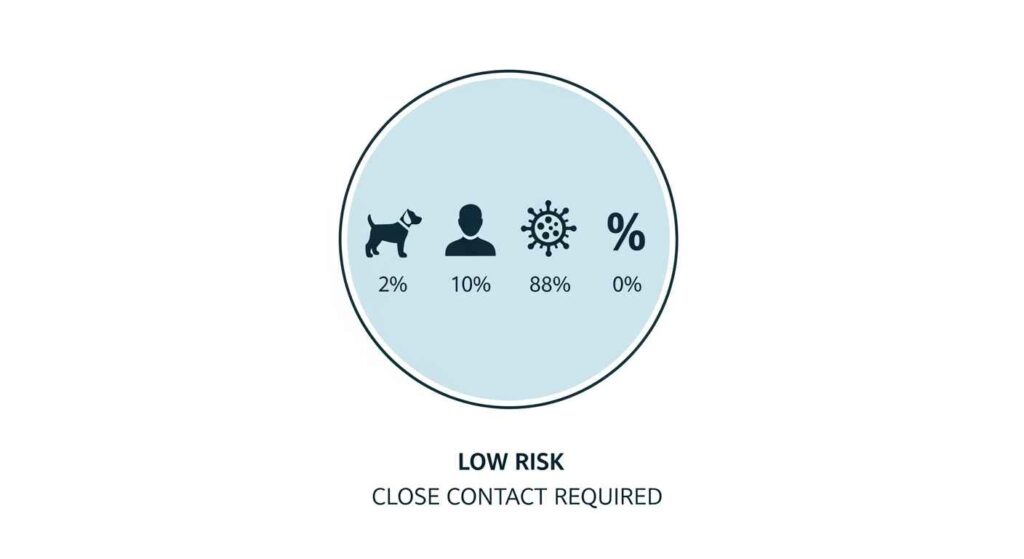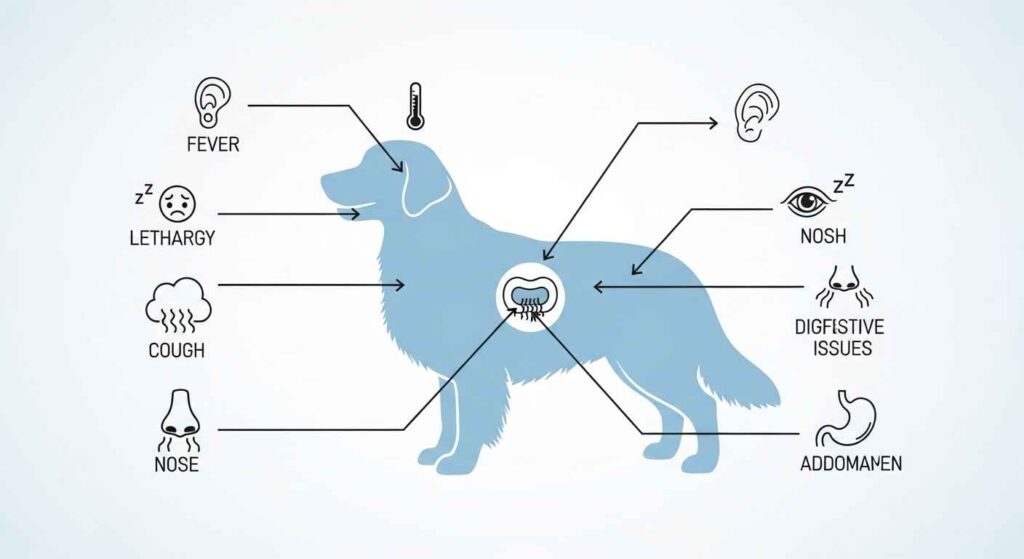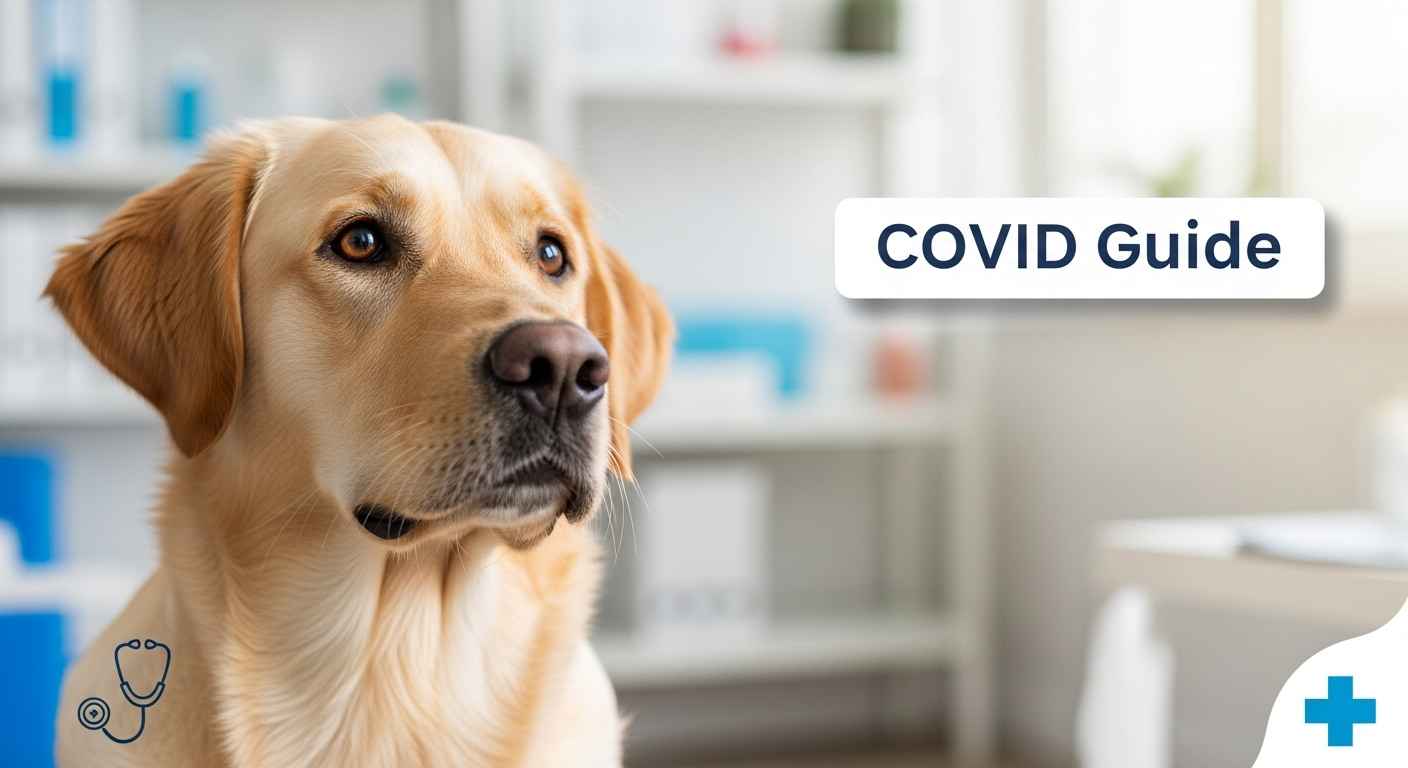Quick Answer: Yes, dogs can get infected with the virus that causes COVID-19 (SARS-CoV-2), but it’s uncommon and usually mild. Most infections occur after close contact with infected humans.
The COVID-19 pandemic raised many questions about pet safety. As a responsible pet parent, you want to know if your furry friend can catch the virus and what to do if they do.
This guide covers everything you need to know about COVID-19 in dogs, based on the latest veterinary research and CDC guidelines.
Can Dogs Actually Get COVID-19?
Dogs can become infected with SARS-CoV-2, the virus that causes COVID-19, mostly after close contact with infected people. However, it’s important to understand the facts:
- Under natural conditions, pet dogs may become infected with SARS-CoV-2 after close and prolonged contact with an infected person
- Pets seldom show signs of severe clinical illness (if at all) when they become infected with the virus
- The risk of pets spreading COVID-19 to people is low

How Do Dogs Get COVID-19?
Dogs typically get infected through:
- Close contact with infected humans – This is the most common way
- Prolonged exposure – Brief interactions rarely cause infection
- Respiratory droplets – When infected people cough, sneeze, or breathe near pets
Dogs and cats in close contact with COVID-19-positive owners have a high risk of getting infected with SARS-CoV-2. The key word here is “close” – this means activities like:
- Sleeping in the same bed
- Face-to-face contact
- Sharing food or water bowls
- Extended cuddling sessions
If you’re concerned about your pet’s health, use our Pet Symptom Checker to help identify potential issues.
COVID-19 Symptoms in Dogs
Most pets that get infected only have mild illness and fully recover. Serious illness in pets is extremely rare.
Common Symptoms Include:
- Respiratory signs: Coughing, difficulty breathing, or shortness of breath
- General illness: Fever, lethargy (unusual tiredness)
- Nasal symptoms: Sneezing, runny nose
- Eye problems: Discharge from eyes
- Digestive issues: Vomiting, diarrhea

Important: No or only mild clinical signs were observed in most cases. Many infected dogs show no symptoms at all.
What to Do if You Think Your Dog Has COVID-19
Step 1: Contact Your Veterinarian
If your pet is sick and you think it might be from the virus that causes COVID-19, talk to your veterinarian.
Don’t rush to the clinic immediately. Instead:
- Call ahead and explain the situation
- Mention if you’ve had COVID-19 recently
- Ask about telemedicine options
Step 2: Monitor Symptoms
It is important to keep track of your pet’s symptoms during home isolation. Keep a written log including:
- Temperature readings
- Appetite changes
- Energy levels
- Any new symptoms
Step 3: Follow Isolation Guidelines
If your vet recommends home isolation:
- Keep your dog at home except for medical care
- Separate infected dogs from other pets if possible
- Follow the same precautions recommended for people caring for an infected person at home
Treatment for Dogs with COVID-19
Most cases in pets are mild and resolve with supportive care, such as ample fluids, good nutrition, and rest.
Home Care Includes:
- Rest: Limit activity and provide comfortable bedding
- Hydration: Ensure access to fresh water
- Nutrition: Maintain regular feeding schedule
- Monitoring: Watch for worsening symptoms
When to Seek Emergency Care
Contact your vet immediately if your dog shows:
- Severe breathing difficulties
- Refusal to eat or drink for more than 24 hours
- Extreme lethargy or weakness
- High fever that doesn’t respond to treatment
For general pet health concerns, our Pet Food Safety Checker can help ensure you’re providing the best nutrition during recovery.
How to Protect Your Dog from COVID-19
If You’re Healthy:
- Maintain normal routines
- Continue regular walks and exercise
- Keep up with veterinary appointments
- Practice good hand hygiene before handling pets
If You Have COVID-19:
If you are sick with COVID-19, you should avoid contact with your pets and other animals, just like you would with people.
Avoid these activities when sick:
- Petting or cuddling
- Kissing or face-to-face contact
- Sharing food or drinks
- Sleeping in the same bed

Common Myths About Dogs and COVID-19
Myth 1: Dogs Can Easily Spread COVID to Humans
Truth: The risk of pets spreading COVID-19 to people is low. Pet-to-human transmission seemed negligible.
Myth 2: You Should Disinfect Your Dog’s Fur
Truth: Do not wipe or bathe your pet with chemical disinfectants, alcohol, hydrogen peroxide, or other products, such as hand sanitizer. There’s no evidence the virus spreads through pet fur.
Myth 3: Dogs Need Face Masks
Truth: Do not put masks on pets; masks could harm your pet.
Myth 4: All Dogs Will Get Severely Ill
Truth: Serious illness in pets is extremely rare. Most dogs either show no symptoms or experience mild illness.
Canine Coronavirus vs. COVID-19: Key Differences
It’s crucial to understand that canine coronavirus is fundamentally different from Covid-19, and CCoV cannot be caught by people.
Canine Coronavirus (CCoV):
- Dog-specific virus
- Cannot infect humans
- Primarily causes digestive issues
- Has existed for decades
COVID-19 (SARS-CoV-2):
- Can infect multiple species including dogs
- Primarily respiratory illness in humans
- Emerged in 2019
- Usually mild in dogs
For more information about other health concerns in dogs, check out our guide on can dogs get flu.
When Can Your Dog Return to Normal Activities?
Your pet can usually go back to normal activities if the pet has not shown symptoms for at least 72 hours without medical care AND it has been at least 14 days since the pet’s last positive test.
Safe Return Criteria:
- Symptom-free for 72 hours minimum
- 14 days since positive test OR negative follow-up tests
- Veterinarian approval for return to normal activities
Frequently Asked Questions
Can puppies get COVID-19?
Yes, puppies can get infected just like adult dogs. However, there’s no evidence they’re at higher risk for severe illness.
Should I cancel my dog’s veterinary appointments?
No, maintain regular veterinary care. Most clinics have safety protocols in place. Preventive care remains important for your dog’s overall health.
Can my dog get COVID from other dogs?
Pet-to-pet transmission within households was not detected in studies. Human-to-pet transmission is much more common than pet-to-pet transmission.
What if I need to travel with my dog during COVID?
Check local regulations and airline policies. Ensure your dog is healthy before traveling, and maintain safety protocols during the journey.
Related Health Concerns
While COVID-19 is usually mild in dogs, it’s important to stay informed about other health issues that can affect your pet:
- Can dogs get hiccups? – Learn about normal vs. concerning symptoms
- Can dogs get lice? – Another contagious condition to be aware of
- Common dog owner mistakes – Avoid these health and care errors
The Bottom Line
COVID-19 in dogs is possible but uncommon. When it does occur, it’s usually mild and resolves with basic supportive care. The most important thing is maintaining open communication with your veterinarian and following public health guidelines.
The risk of animals spreading COVID-19 to people is low, so there’s no need to panic or make drastic changes to your pet care routine.
Stay informed, practice good hygiene, and continue providing the love and care your dog needs. If you’re ever unsure about your pet’s health, don’t hesitate to use our Pet Symptom Checker or contact your veterinarian.
Remember: This information is for educational purposes only. Always consult with your veterinarian for personalized advice about your dog’s health and any COVID-19 concerns.
